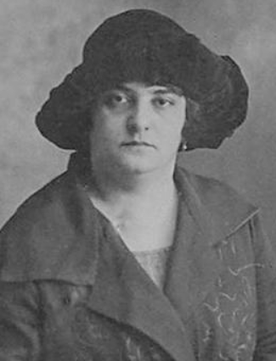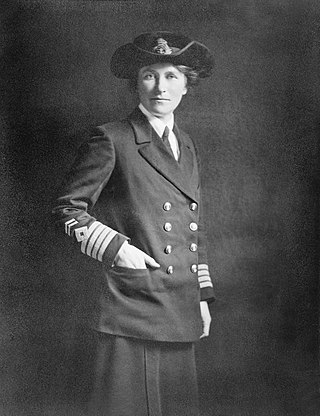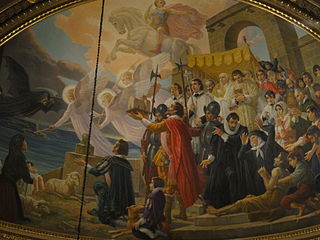
Kalkara is a village in the South Eastern Region of Malta, with a population of 3,014 as of March 2014. The name is derived from the Latin word for lime (Calce), and it is believed that there was a lime kiln present there since Roman times. Kalkara forms part of the inner harbour area and occupies the area around Kalkara Creek. The town has its own Local Council and is bordered by the cities of Birgu and Żabbar, as well as the town of Xgħajra.

The Castellania, also known as the Castellania Palace, is a former courthouse and prison in Valletta, Malta that currently houses the country's health ministry. It was built by the Order of St. John between 1757 and 1760, on the site of an earlier courthouse which had been built in 1572.

Royal Naval Hospital Bighi also known as Bighi Hospital, was a major naval hospital located in the small town of Kalkara on the island of Malta. It was built on the site of the gardens of Palazzo Bichi, that was periodically known as Palazzo Salvatore. RNH Bighi served the eastern Mediterranean in the 19th and 20th centuries and, in conjunction with the RN Hospital at Mtarfa, contributed to the nursing and medical care of casualties whenever hostilities occurred in the Mediterranean. The building is now known as Villa Bighi and it houses a restoration unit.

Prostitution in Malta is itself legal, but certain activities connected with it, such as running a brothel and loitering, are not. Certain offences are punishable by sentences of up to two years in prison. In March 2008, police and the Malta Ministry for Social Policy signed a memorandum of understanding to formalize a screening process for all arrested persons engaged in prostitution to determine whether they were victims of trafficking or other abuses. The law provides punishments of up to 6 years for involving minors in prostitution.

The Westmoreland Lock Hospital was a hospital for venereal disease originally located at Donnybrook and later moved to Lazar's Hill, Dublin, Ireland.

Fra' Jean "Parisot" de (la) Valette was a French nobleman and 49th Grand Master of the Order of Malta, from 21 August 1557 to his death in 1568. As a Knight Hospitaller, joining the order in the Langue de Provence, he fought with distinction against the Turks at Rhodes. As Grand Master, Valette became the Order's hero and most illustrious leader, commanding the resistance against the Ottomans at the Great Siege of Malta in 1565, sometimes regarded as one of the greatest sieges of all time.

Giovanni Bonello is a Maltese judge, judge of the European Court of Human Rights from 1998 until 2004, then extended till 2010.

The Mediterranean Conference Centre is a conference centre in Valletta, Malta. The building was built as a hospital in the 16th century by the Order of St. John, and it was known as the Sacra Infermeria or the Holy Infirmary. It was known as the Grand Hôspital during the French occupation of Malta and during the British period was named as the Station Hospital.

The Auberge de Bavière is a palace in Valletta, Malta. It was built as Palazzo Carneiro in 1696, and it was the residence of Grand Master Marc'Antonio Zondadari in the early 18th century. In 1784, it was converted into the auberge for the Anglo-Bavarian langue of the Order of Saint John, and it remained so until the French occupation of Malta in 1798.

The Nibbia Chapel was a Roman Catholic chapel in Valletta, Malta, which was dedicated to Our Lady of Mercy. It was originally built in 1619 by Fra Giorgio Nibbia, a knight of the Order of St. John, and it was located near a cemetery where deceased patients from the nearby Sacra Infermeria were buried.

The Basilica of Our Lady of Mount Carmel is a Carmelite Roman Catholic minor basilica dedicated to Our Lady of Mount Carmel, located in Valletta, Malta. It is one of the major churches of Valletta, and it forms part of a UNESCO World Heritage Site which includes the entire city. The present church was constructed between 1958 and 1981 on the site of a late 16th century church which was destroyed during World War II.

Spinola Palace, also known as Spinola House and Villa Spinola, is a palace in St. Julian's, Malta. It was built in the 17th century by Fra Paolo Rafel Spinola, a knight of the Order of St. John, and was enlarged in the 18th century. The later construction was designed by Romano Carapecchia, which is considered a masterpiece, with its back having an elegant clock that is a unique feature to secular Baroque architecture in Malta.

The Slaves' Prison officially known as the Grand Prison and colloquially as the bagnio, was a prison in Valletta, Malta. It was established in the late 16th century, and remained in use as a prison throughout the 17th and 18th centuries. It was subsequently used as a naval hospital, a school and an examination hall. It was bombed in World War II, and the ruins were demolished to make way for a block of flats.

Caterina Vitale (1566–1619) was the first female pharmacist and chemist in Malta, and the first female pharmacist of the Knights Hospitaller.

The history of leprosy in Malta began in the Middle Ages, but the disease became particularly prevalent in the Maltese archipelago during the 19th century.

Irene Condachi was a Maltese physician, one of only two female doctors practicing on the island during World War II. One of the founders of the school medical service, she became the medical officer for the government school and is credited with eradicating scabies in the education system.

Dorothy Christian Hare, CBE was an English physician. She joined the Royal Army Medical Corps and Women's Royal Naval Service during the First World War where she became concerned about the treatment of venereal disease in women. Upon returning to England she established two hostels to improve conditions for such cases. Following a career at the Royal Free Hospital and the Elizabeth Garrett Anderson Hospital she became the third woman and first female general physician to be elected a fellow of the Royal College of Physicians.

The 1675–1676 Malta plague epidemic was a major outbreak of plague on the island of Malta, then ruled by the Order of St John. It occurred between December 1675 and August 1676, and resulted in approximately 11,300 deaths, making it the deadliest epidemic in Maltese history. Most deaths were in the urban areas, including the capital Valletta and the Three Cities, which had a mortality rate of about 41%. In the rural settlements, the mortality rate was 6.9%.

The 1592–1593 Malta plague epidemic was a major outbreak of plague on the island of Malta, then ruled by the Order of St John. It occurred in three waves between June 1592 and September 1593, during the second plague pandemic, and it resulted in approximately 3000 deaths, which amounted to about 11% of the population. The disease was imported to Malta by Tuscan galleys that had captured vessels from Alexandria. In 1593, the Order requested assistance from Sicily to deal with the epidemic, and the measures taken were effective in containing plague.




















